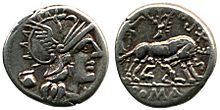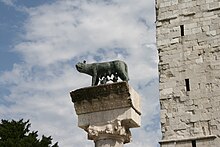Capitoline Wolf
The Capitoline Wolf (lat. Lupa Capitolina ) is a life-size bronze figure of a wolf that Romulus and Remus , the mythical founders of the city of Rome , suckling. The sculpture is 75 cm high and 114 cm wide and is located in the Capitoline Museums in Rome.
According to the generally accepted view since the 18th century, it is said to be an Etruscan sculpture from the 5th century BC. Act; however, recently there have been considerable doubts about this dating. After experts in the course of restoration work had expressed an initial suspicion that the techniques used were unknown before the 11th century AD, the subsequent C-14 dating seems to have shown that the she-wolf was in the Middle Ages , between the 9th and 13th centuries. A final clarification of the question is still pending.
The two boys were no doubt added in the Renaissance , probably by the sculptor Antonio Pollaiuolo .
myth
One of the numerous myths about the beginnings of the city of Rome is the founding story of Romulus and Remus , as told by the Roman historian Fabius Pictor . Afterwards Amulius , the king of the city of Alba Longa in the Alban Mountains, had ousted his brother Numitor Silvius and placed his daughter Rhea Silvia in the temple of Vesta , the goddess of the local hearth. Despite the chastity law applicable to the vestals , Rhea Silvia had given birth to twins to Mars, god of war . Amulius Rhea had Silvia thrown into the Tiber and the twins abandoned in the Tiber. However, the river god Tiber saved the Vestal Virgin and married her.
The raft on which the king's servants had put the children out of pity ran aground at the foot of the Palatine . A she-wolf, an animal sacred to Mars, found the children and suckled them until they were raised by the shepherd Faustulus and his wife Acca Larentia . When they grew up, they killed their great uncle Amulius and reinstated their grandfather Numitor Silvius as king. You founded a new city yourself. When they could not peacefully agree who should rule the city, Romulus killed his brother in the course of an argument. King of the new city was Romulus, after whom the city of Rome is named.
Iconography of the Lupa Romana
The Lupa Romana (= Roman she-wolf) is an extremely popular motif on medals, coins, gems, reliefs, mosaics, etc., especially during the Roman Empire . The she-wolf initially appears without Romulus and Remus , who did not appear until the 3rd century BC. Are regularly depicted. The posture of the Capitoline She-Wolf , turning her head with the twins sitting under her, is the model for most of the later variants of the motif. The Lupa Romana serves as a symbol for the divine origin of the city's founder Romulus, the son of the god of war Mars , as well as the claim to eternity, the aeternitas , the city and the empire. As a symbol of eternity and immortality, the she-wolf occasionally appears on grave monuments as a sign of imperial claims, especially on objects in the subjugated provinces.
The tradition of the she-wolf with Romulus and Remus as symbols for the city of Rome has been unbroken since Roman times. As an instrument of propaganda it was used by Mussolini , who saw himself as the founder of a New Rome , who sent three copies to American cities. It served as an emblem at the 1960 Olympic Games . It can still be seen on signs of the Commune of Rome to this day, and it is occasionally used as a distinctive trademark in advertising for Roman companies and products.
History of sculpture
According to tradition, the Capitoline Wolf is one of the few ancient sculptures in Rome that never lay underground, but has always remained publicly visible. In his work De divinatione, Cicero mentions the statue of a she-wolf that was erected on the Capitol in Rome and that was erected in 65 BC. Was struck by lightning. Some authors would like to see the statue mentioned by Cicero in the she-wolf. The traces of the lightning strike mentioned by other ancient authors could not be found on this figure.
According to sources from the 10th century, the statue was placed in front of the old Lateran Palace . Then it was kept in the church of San Teodoro al Palatino . In 1471 Pope Sixtus IV gave the she-wolf to the conservators of the city of Rome in the course of furnishing the Capitol Square with antiquities. The payment of 10 gold florins by Sixtus may have served as a fee for Antonio Pollaiuolo , who is said to have added the twins around this time. Until 1583 the statue was placed on a pedestal in the portico of the Conservator's Palace. Since 1586 it has stood on a pedestal in the middle of the Sala della Lupa in the Conservators' Palace as part of the Capitoline Museums . There is a copy in front of the north-west corner of the Senator's Palace.
Dating
Until the beginning of the 21st century, the statue was widely regarded as a masterpiece of Etruscan art . Giulio Quirino Giglioli dated it to the 5th century BC. And attributed it to an Etruscan workshop, the German archaeologist Friedrich Matz dated it to 480-470 BC. Chr.
According to the thesis of the Roman archaeologist Adriano La Regina , which he published in the daily newspaper La Repubblica , the she-wolf could not have been cast until the Middle Ages. He relies on the results of the Roman restorer Anna Maria Carruba, who carefully examined the figure in 1997 as part of a comprehensive restoration. According to Carruba, the figure was cast in one piece, a technique that is characteristic of medieval bronze castings. Ancient - Greek, Etruscan and Roman - bronzes of this size were, without exception, cast in individual parts, which were then put together and reworked. The typical characteristics of this technology are missing in the she-wolf, which was rather manufactured in a way that was not used in Italy until the 11th century. Carruba's results had not been published when the she-wolf was re-erected in the Sala della Lupa , and the Capitoline Museums stuck to the old date until early summer 2012. Since then, however, the date on the museum's website has been given: V sec. A. C. o età medievale ("5th century BC or Middle Ages").
In research, La Regina's theses are not without controversy. It is argued that there are many Greco-Roman comparative pieces, but only one known Etruscan bronze of a similar size, the Arezzo Chimera . Whether the Etruscan and Greco-Roman casting techniques were really identical has to be proven first. According to Maurizio Sannini, the material from which the she-wolf was cast was used in Roman times, but no longer in post-ancient times.
Using spectrometric methods, organic material was extracted from the casting manufacturing process, which researchers at the Università del Salento analyzed in June 2012 with the help of radiocarbon studies. Accordingly, the work of art must have been created in the 11th to 12th centuries. This makes it much more likely that Carruba's idea is correct and that the she-wolf did not come into being until the Middle Ages, when people began to think back to the Roman past, especially in northern Italy.
Luca Giuliani comes to a skeptical judgment in his remarks on the attempts at dating the Capitoline she-wolf - precisely because the scientific results are so disparate. He by no means considers the discussion about the suggestion of an origin in the Middle Ages to be over, since the mention in the "Libellus de imperatoria potestate in urbe Roma" seems to be the earliest credible mention that dates back to the 10th century.
Copies of the Capitoline Wolf
The Capitoline Wolf is also venerated in the city of Siena. According to legend, Remus' sons, Ascanius and Senius, were forced to flee Rome after their father was slain by his brother Romulus. On their flight to northern Italy they came to what is now Siena, where they built a castle on a hill. This castle, called Castelvecchio or Castel Senio , is considered to be the founding place of the city of Siena . A modern bronze sculpture of the she-wolf is placed in the Palazzo Pubblico .
In Aquileia in northern Italy, the Capitoline Wolf stands in the forecourt of the Basilica of Aquileia . Romania has had a Capitoline Wolf in Timișoara since 1926 . Copies and reproductions of the Capitoline Wolf can also be found in the small Romanian town of Sighișoara , in front of the National Historical Museum of the Moldovan capital Chișinău and in Paris in front of the Musée national du Moyen-Age .
literature
- Claudio Parisi Presicce (Ed.): La lupa capitolina. Electa, Milan 2000, ISBN 88-435-7544-9 .
- Anna Maria Carruba: La Lupa Capitolina. Un bronzo medievale. Presentazione di Adriano La Regina. De Luca, Rome 2006, ISBN 88-8016-753-7 .
- Maria Radnoti-Alföldi , Edilberto Formigli, Johannes Fried : The Roman she-wolf. An ancient monument falls from its pedestal. Franz Steiner Verlag, Stuttgart 2011, ISBN 978-3-515-09876-2
- Maria Aurora von Hase-Salto: A work of the Middle Ages. New knowledge about the Capitoline Wolf. In: Antike Welt 43, 5, 2012, pp. 53–56.
Web links
- Statue of the Capitoline Wolf in the Arachne archaeological database
- Lupa Capitolina (Italian text) with 15 figs.
Remarks
- ↑ Inventory number MC 1181.
- ^ Richard Weigel: Lupa Romana . In: Lexicon Iconographicum Mythologiae Classicae . Vol. 6. Artemis, Zurich / Munich 1992. pp. 292-296.
- ↑ Weigel p. 296.
- ^ Benedict of St. Andrea: Chronicon .
- ↑ Homepage of the Capitoline Museums
- ^ Adriano La Regina: Roma, l'inganno della Lupa è “nata” nel Medioevo . In: La Repubblica from November 17, 2006. Then Urs Willmann: Too young for antiquity . In: Die Zeit , February 22, 2007.
- ↑ Musei capitolini. Lupa Capitolina , accessed April 22, 2019
- ^ Fabio Isman: A questo punto la Lupa Capitolina è solo un mistero . In: Il Messagiero . March 1, 2007.
- ↑ Dall'Etruria al Medioevo. Con il radiocarbonio la Lupa capitolina è più giovane di 17 secoli . In: Corriere della Sera of June 22, 2012 .
- ↑ Luca Giuliani: Review of: M. Radnoti-Alföldi, E. Formigli, J. Fried, Die Römische Wölfin. An ancient monument falls from its pedestal (2011). In: Klio 95, 2013, pp. 272–276.
Coordinates: 41 ° 53 ′ 36 ″ N , 12 ° 29 ′ 1 ″ E





